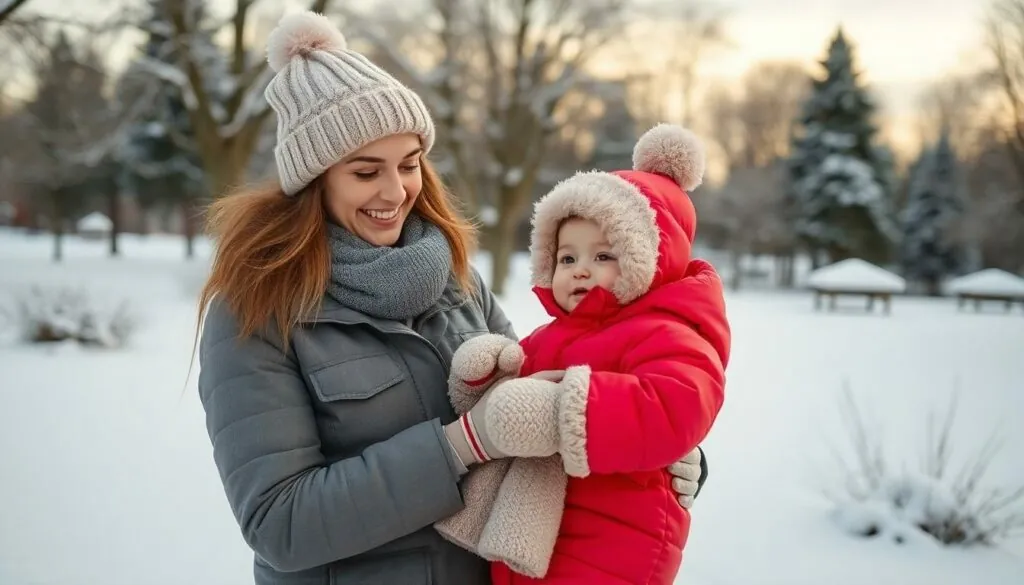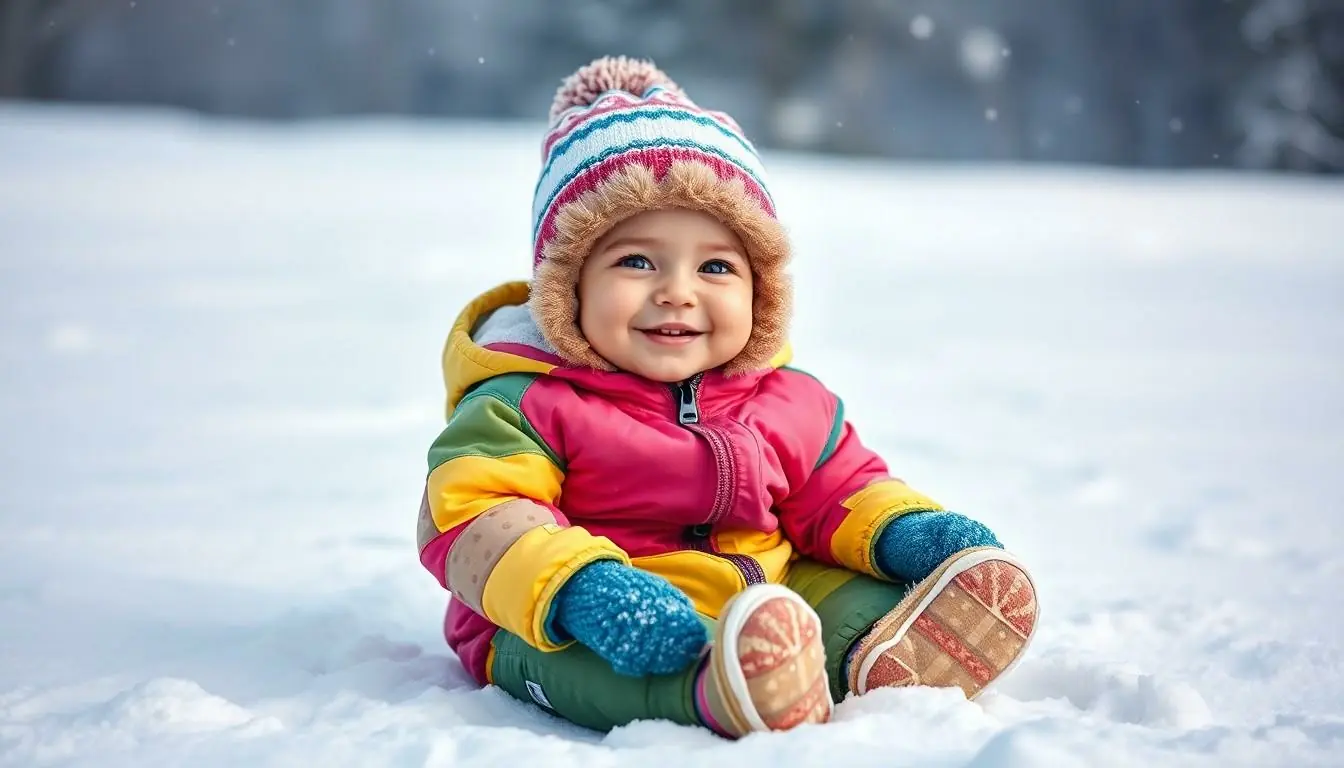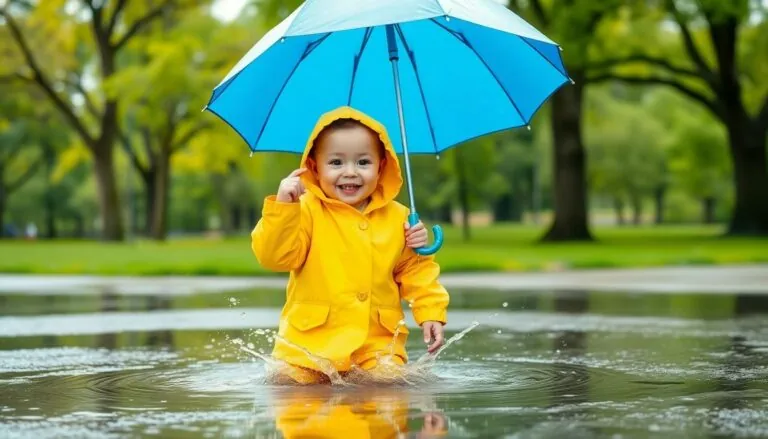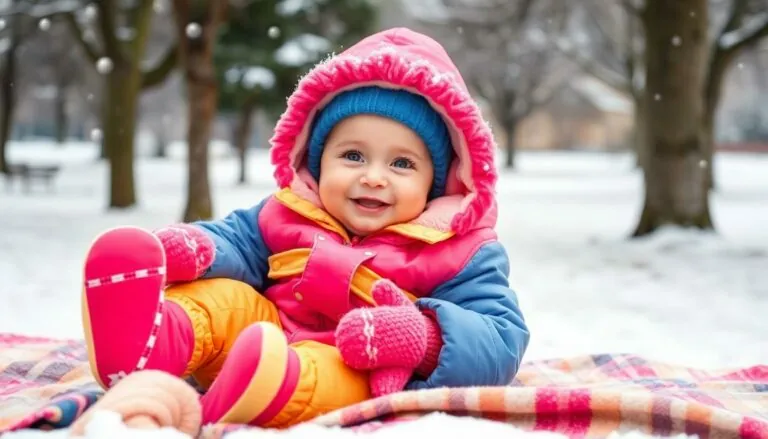Table of Contents
ToggleWhen the temperature drops and snowflakes start to dance, it’s time to bundle up the little ones. Baby winter gear isn’t just about keeping them warm; it’s a fashion statement that says, “I’m cute and cozy!” From snuggly snowsuits to adorable booties, parents face the delightful challenge of choosing the best gear to keep their tiny tots toasty.
Overview of Baby Winter Gear
Essentially, baby winter gear includes a range of clothing designed to keep infants warm while maintaining style. Parents often find snowsuits particularly beneficial during colder months. Snowsuits offer insulation with thick fabric, ensuring babies stay cozy in harsh conditions.
Booties serve as another crucial piece, providing warmth for tiny feet. These booties come in various materials, including fleece and wool, which help to retain heat effectively. Mittens are also important; they protect delicate hands from the cold and enhance overall comfort during winter outings.
Layering clothing adds flexibility for parents to adjust their baby’s warmth easily. A thermal bodysuit can serve as an ideal base layer, while a warm sweater offers an excellent second layer. Lightweight jackets add outer protection while preventing overheating.
Accessories enhance functionality and style, too. Warm hats cover heads and prevent heat loss, which is essential in frigid temperatures. Scarves can also add an additional warmth layer, ensuring neck areas stay insulated.
Choosing high-quality fabrics improves warmth retention. Materials like cotton and fleece keep babies comfortable while allowing for airflow. Safety remains paramount when selecting gear, so ensure that clothes fit properly and do not restrict movement.
Investing in proper winter gear proves valuable for enhancing outdoor experiences. When equipped with the right clothing, parents can confidently enjoy winter activities without worrying about their baby’s comfort or health. Looking for these essential items will ensure that infants stay warm and stylish all season long.
Importance of Keeping Babies Warm
Maintaining warmth in infants during winter months is crucial for their health and comfort. Parents must prioritize safeguarding their little ones against cold weather.
Risks of Cold Weather Exposure
Cold weather exposure poses several risks for infants. Hypothermia can occur rapidly, leading to dangerously low body temperatures. Frostbite also affects vulnerable skin on extremities like fingers and toes. Immune system compromise increases, making babies more susceptible to illnesses. Parents should recognize that even short periods in frigid conditions can escalate these risks. Dressing babies in proper winter gear can significantly mitigate these dangers and protect their overall well-being.
Benefits of Proper Insulation
Proper insulation offers numerous benefits for babies in winter. Insulated clothing provides warmth without excessive bulk, ensuring comfort during outdoor activities. Layered outfits allow for easy adjustment to changing temperatures, keeping infants at a safe temperature. Comfortable gear encourages outdoor exploration, fostering essential developmental experiences. Safe, high-quality materials enhance protection against weather elements and allow free movement. Optimizing insulation leads to happy, healthy babies enjoying the beauty of winter weather.
Essential Baby Winter Gear Items
Choosing the right winter gear for infants ensures comfort during colder months. Several items stand out as necessities for keeping babies warm and cozy.
Baby Coats and Snowsuits
Baby coats and snowsuits provide essential insulation against winter’s chill. These garments come in various styles, from puffy snowsuits to lightweight jackets, ensuring options for different weather conditions. A well-insulated snowsuit retains warmth without bulking up. Parents should prioritize breathable fabrics that also allow for movement while maintaining warmth. Look for snowsuits with adjustable features for a customized fit. Coats with hoods add extra protection for delicate ears, contributing to overall warmth.
Winter Accessories
Winter accessories play a vital role in completing baby’s winter attire. Warm hats protect the head from cold, and those made from wool or fleece offer excellent insulation. Mittens or booties keep tiny hands and feet toasty, with options featuring waterproof materials for wet conditions. Scarves provide added warmth and can be wrapped snugly around the neck. Layering these accessories enhances comfort and flexibility, allowing for easy adjustments during outdoor activities. Each accessory should fit securely without restricting movement, ensuring babies stay warm and safe.
Choosing the Right Size and Fit
Selecting the right size for baby winter gear is crucial. Parents must consider the infant’s current size and growth potential. Refer to brand-specific sizing charts, as these vary between manufacturers.
Choosing clothing that’s slightly larger can allow for layers underneath but avoid excess bulk. Proper fit ensures that heat retention occurs without restricting movement or comfort. Snowsuits should have enough room for layering but not so much that they compromise warmth.
When it comes to accessories, hats should fully cover the ears while remaining snug; mittens need to stay on small hands but not restrict circulation. Booties should fit securely without slipping off, offering warmth while allowing for natural foot movement.
Always look for adjustable features like cuffs and waistbands. Adjustable elements facilitate a customizable fit, accommodating growth throughout the winter season.
Fabric types also influence the overall fit. Materials like fleece stretch while also trapping warmth. Maternity or baby-specific brands often incorporate stretchy fabrics, enhancing comfort and ease of wear.
Overall, the combination of proper sizing and suitable fabric leads to optimal comfort for the baby during colder months. Prioritizing fit prevents discomfort, ensuring infants can enjoy outdoor activities safely and happily.
Fabric Types and Insulation Materials
Choosing the right fabric and insulation material is essential for baby winter gear. Several options offer warmth and comfort.
Fleece is a popular choice due to its lightweight warmth, making it suitable for layers. Wool provides excellent insulation while being breathable, ensuring moisture-wicking properties to keep baby dry.
Polyester blends form another useful option, combining durability with softness. Many winter garments use a waterproof coating to ensure babies remain dry in snowy conditions.
Thinsulate insulation adds minimal bulk while maintaining warmth, allowing for unrestricted movement. This material stands out for providing warmth without heavy layers, ideal for active babies.
Down insulation offers superior warmth and compressibility, but careful selection is necessary for babies with allergies. Synthetic down alternatives provide similar benefits without allergenic risks.
For those preferring mixed materials, look for combinations like cotton with thermal insulation. This style provides comfort and warmth while allowing for easy movement.
Breathable fabrics are crucial for regulating body temperature. A blend of moisture-wicking properties and air circulation prevents overheating during outdoor play.
When selecting baby winter gear, consider the climate and individual needs. Different insulating materials cater to varying temperatures, ensuring comfort in any setting.
Prioritizing high-quality fabrics and insulation materials contributes significantly to a baby’s well-being during winter months. Proper gear not only keeps babies warm but also enhances their outdoor experiences, enabling enjoyment without restriction.
Tips for Dressing Babies in Winter
Dressing babies properly during winter ensures they stay warm and comfortable. It’s vital to use effective methods and materials while dressing little ones for the cold.
Layering Techniques
Layering provides flexibility and comfort for babies in winter. Start with a thermal bodysuit as a base layer, which maintains warmth without adding bulk. Next, a warm sweater serves as a second layer, wrapping them in cozy insulation. Outer layers, like lightweight jackets, are ideal for keeping the chill out while preventing overheating. Ensure each layer fits snugly without restricting movement to allow active play. Parents might choose materials that balance warmth and breathability, such as fleece or wool. Each layer plays a critical role in regulating body temperature throughout changing weather conditions.
Safety Considerations
Safety is paramount when selecting winter gear for infants. Clothing must fit properly, offering warmth without being too constrictive. Accessories should also maintain a secure fit, preventing accidental loss or choking hazards. Avoid bulky items that impede movement, as mobility supports development during outdoor exploration. Additionally, high-quality fabrics are crucial for insulation and moisture control, reducing the risk of hypothermia. Parents should regularly check that hats, mittens, and booties still fit well, adjusting as necessary for growth. Ensuring that babies have proper winter gear safeguards their comfort and health during colder months.
Conclusion
Choosing the right baby winter gear is essential for keeping little ones warm and safe during chilly months. Quality clothing not only provides insulation but also allows for freedom of movement. By layering effectively and selecting the right materials parents can ensure their babies stay comfortable while exploring the winter wonderland.
Investing in stylish yet functional winter attire enhances outdoor experiences for both parents and infants. With the right gear babies can enjoy the beauty of winter without the worry of cold-related health risks. Embracing this season with confidence means dressing babies in cozy layers and protective accessories, making every winter outing a delightful adventure.








